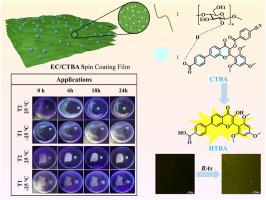基于黄酮醇的生物胺自组装传感器及其在鱼虾新鲜度检测中的应用
IF 6.3
1区 农林科学
Q1 FOOD SCIENCE & TECHNOLOGY
引用次数: 0
摘要
生物胺(BAs),如尸胺(Cad)、腐胺(Put)和精胺(Spe),是肉类新鲜度的关键指标。在这项研究中,我们开发了一种新的黄酮醇衍生的荧光探针,4 -(3-(4-氰苯甲酰)氧)-4-氧-2-(2,4,6-三甲氧基)- 4h -铬-7-基)苯甲酸(CTBA)。CTBA对BA表现出敏感和选择性的荧光响应,在510 nm处有明显的发射峰,随BA浓度成比例地增强。对于Cad,探头的线性检测范围为0-45 μM,低检测限(LOD)为0.36 μM。通过1H NMR和高分辨率质谱(HRMS)验证了CTBA与尸胺的相互作用机制。此外,利用氢键相互作用,利用乙基纤维素(EC)自旋涂覆CTBA制备了复合荧光膜。该薄膜已成功应用于鱼、虾的新鲜度实时监测。我们的工作介绍了一种开创性的双功能材料,能够双重用途包装和新鲜度检测,为加强食品安全协议提供了巨大的潜力。本文章由计算机程序翻译,如有差异,请以英文原文为准。

A novel flavonol-based self-assembled sensor with high sensitivity to biogenic amines and application in detection of fish and prawn freshness
Biogenic amines (BAs), such as cadaverine (Cad), putrescine (Put), and spermine (Spe), serve as critical indicators of meat freshness. In this study, we developed a novel flavonol-derived fluorescent probe, 4-(3-((4-cyanobenzoyl)oxy)-4-oxo-2-(2,4,6-trimethoxyphenyl)-4H-chromen-7-yl)benzoic acid (CTBA). CTBA exhibited a sensitive and selective fluorescence response to BAs, with a pronounced emission peak at 510 nm that intensified proportionally with BA concentration. For Cad, the probe demonstrated a linear detection range of 0–45 μM, achieving a low limit of detection (LOD) of 0.36 μM. The interaction mechanism between CTBA and cadaverine was validated through 1H NMR and high-resolution mass spectrometry (HRMS). Furthermore, a composite fluorescent film was fabricated by spin-coating CTBA with ethyl cellulose (EC), leveraging hydrogen-bonding interactions. This film was successfully applied for real-time monitoring of freshness in fish, and prawn. Our work introduces a pioneering bifunctional material capable of dual-purpose packaging and freshness detection, offering significant potential for enhancing food safety protocols.
求助全文
通过发布文献求助,成功后即可免费获取论文全文。
去求助
来源期刊

Food Control
工程技术-食品科技
CiteScore
12.20
自引率
6.70%
发文量
758
审稿时长
33 days
期刊介绍:
Food Control is an international journal that provides essential information for those involved in food safety and process control.
Food Control covers the below areas that relate to food process control or to food safety of human foods:
• Microbial food safety and antimicrobial systems
• Mycotoxins
• Hazard analysis, HACCP and food safety objectives
• Risk assessment, including microbial and chemical hazards
• Quality assurance
• Good manufacturing practices
• Food process systems design and control
• Food Packaging technology and materials in contact with foods
• Rapid methods of analysis and detection, including sensor technology
• Codes of practice, legislation and international harmonization
• Consumer issues
• Education, training and research needs.
The scope of Food Control is comprehensive and includes original research papers, authoritative reviews, short communications, comment articles that report on new developments in food control, and position papers.
 求助内容:
求助内容: 应助结果提醒方式:
应助结果提醒方式:


